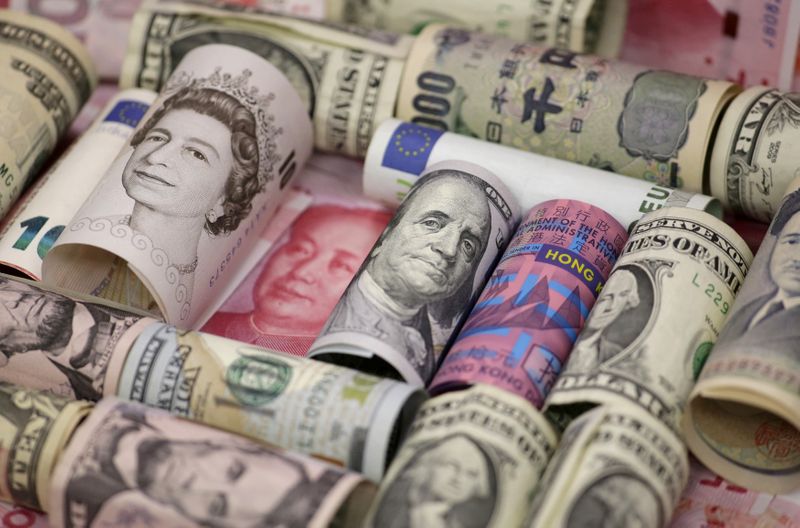
FILE PHOTO: Euro, Hong Kong dollar, U.S. dollar, Japanese yen, British pound and Chinese 100-yuan banknotes are seen in a picture illustration shot January 21, 2016. REUTERS/Jason Lee/Illustration/File Photo
December 23, 2019
LONDON (Reuters) – The dollar stood near two-week highs on Monday after the release of decent U.S. economic data late last week, while sterling’s brief recovery hit the buffers.
With the economic calendar light before the holidays, analysts doubt major currencies will post significant moves this week.
Data published on Friday showed the U.S. economy, already enjoying a record expansion, appeared to have maintained its moderate growth as the year ended.
The dollar has broadly benefited this year both during bouts of risk aversion – because it is considered a safe-haven currency – and when markets have rallied, because the U.S. economy is outperforming other parts of the world.
The greenback was unchanged against the euro at $1.108 on Monday <EUR=EBS>. Against a basket of currencies it stood at 97.694, holding near Friday’s peak, which was the highest since Dec. 6.
Many analysts say the dollar is the most attractive currency of a bad bunch. U.S. yields have dropped in 2019, but still offer better returns than elsewhere.
“The big picture remains though that the dollar continues to struggle for direction again the other major currencies amidst record low volatility,” MUFG analysts wrote in a note, pointing to the modest 1.5% rise for the dollar index in 2019.
The dollar has also been supported since Washington and Beijing came to an interim trade agreement earlier this month. China said on Monday it would lower tariffs on some products next year.
Currencies linked closely to the prospects for global trade rose.
The Australian dollar, which reflects sentiment towards China, rose 0.2% to $0.6921 <AUD=D3>. New Zealand’s dollar gained 0.2% to $0.6619 <NZD=D3>.
Sterling suffered its worst week in three years last week after Prime Minister Boris Johnson ruled out extending a transition period for Britain to negotiate a trade deal with the European Union beyond the end of 2020.
An attempt at recovery quickly fizzled out on Monday leaving sterling down 0.1% at $1.2975 <GBP=D3>, back at levels seen before Johnson gained a resounding majority in the general election.
Versus the euro, sterling eased 0.1% to to 85.35 pence per euro <EURGBP=D3>.
Japan’s yen was little changed at 109.39 yen per dollar <JPY=EBS>. Kit Juckes, an analyst at Societe Generale, noted that Japan’s recent stimulus announcements showed that the country “is leaning towards fiscal policy where Europe struggles to find new sources of easing.
“The yen remains fast asleep, but it will wake up before the euro does,” he said.
The euro gained 0.2% versus Sweden’s crown to 10.44 crowns <EURSEK=D3>. The Swedish currency hit an eight-month high of 10.413 crowns per euro last week before the Riksbank became the first major central bank to end negative interest rates.
(Reporting by Tommy Reggiori Wilkes; Editing by Larry King, Kirsten Donovan)

